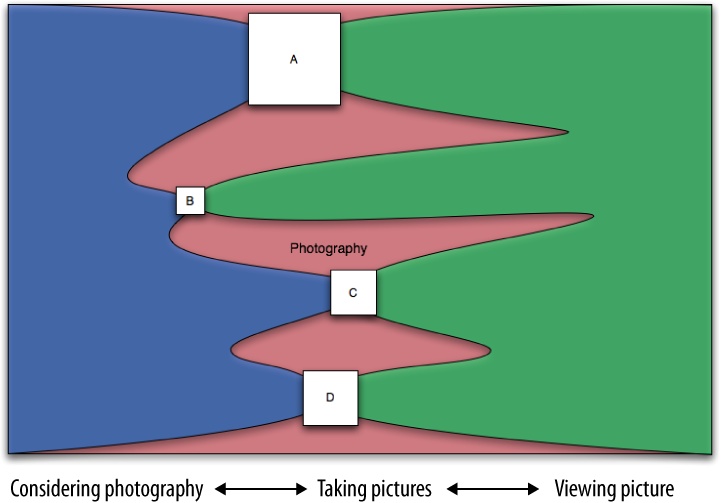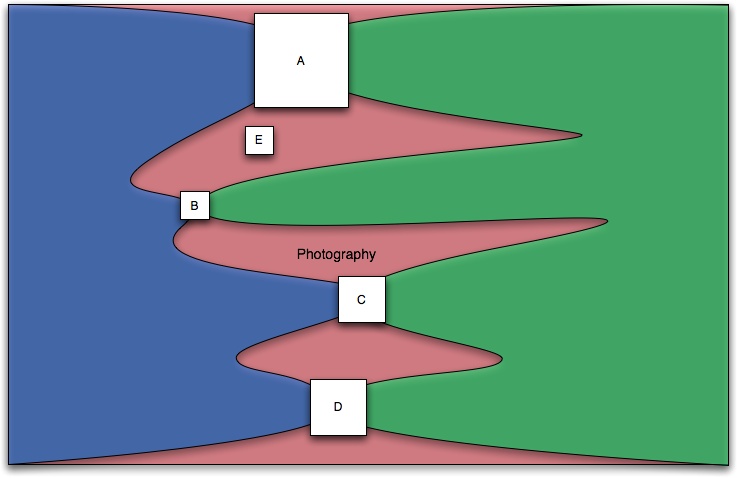“Why are you building a community?”
If you cannot answer this question after a few seconds of thought, the odds are good that no one coming to your site will be able to, either. The elevator pitch should be about value for them, not for you. What will make them stay around?
Social applications come in three main types: those that focus on products, those that focus on content, and those that focus on activity. You need to decide what will be a good fit for your community or the community you want to attract, as well as understand what is happening in related communities and sites.
There are many ways to visualize this. As an example, Figure 1-1 shows the areas of photography captured by various imaginary websites. The lefthand side represents the act of taking pictures, and the righthand side represents the act of viewing photos. Different sites sit at different places in this process. A–D represent companies that each have a single and different product aimed at this market. Perhaps B is more focused on technical advice about taking photos, while C and D are more focused on viewing pictures.
Figure 1-1. Flow of activity and corresponding web applications; each box represents a potential social application for photography
A new company might want to offer something different—perhaps E positioned as shown in Figure 1-2. At one level, noting where the other products are in the market in relation to you is simple competitor analysis—finding places that aren’t already occupied—but there is more to it than that. To build a good application, you need to understand the flow of activity and how your project might fit into this flow.
Note
A large part of this decision making draws on psychology as well as marketing or advertising approaches. Mark Earls’ book Herd (Wiley) provides an excellent description of how mass audiences behave. Despite the frequent focus on individuals in social software, it is important to understand group activity, too.
Applications are based on the activities and behaviors of your community, but you can also borrow ideas from some of the great social applications on the Internet. I reference about 40 to 50 different sites in this book, but I focus on only a small number of well-known ones: Twitter, Last.fm, Flickr, and Dopplr. I chose these because they are popular, I use them, and they represent different types of sites. Roughly speaking, Twitter is a general conversation site; Last.fm is for listening to and recommending music; Flickr is for talking about photography and (personally) significant events; and Dopplr, the newest of the four sites, is a service for travelers.
Your site needs to make sense to an individual for him to use it—he needs to gain something from his solo interaction with the tools on your site, or at least see the sense in using the application. Community then happens almost as a by-product of the user’s interaction with others. You cannot set out with the goal of creating a community. You can start with something that makes sense if lots of people use it, but you need to offer a core tool that makes sense when it’s used alone. This acts as the scaffolding to support users returning to the site, where they will hopefully start to become part of a community for themselves.
Modern web applications need to be social by default. The Web no longer places site owners in a position above those who use their sites. No longer is it enough to see your site as a destination and to bolt on a message board as a small token toward interactivity. There has been a shift from issuing a persistent identity, which started with webmail (Hotmail, Gmail), to recognizing the external identities of the people using your products.
Many people now have a place on the Internet that they call home, and they are just visiting you. Integrating the preexisting lives of these individuals with your site gives them a richer and deeper connection to it. Bear in mind that you are likely to be drawing together an existing community, as it is hard to create a new community online completely from scratch. The groups you draw in will behave in a similar manner to real-world groups of people; after all, they are still human beings. Imagining that you are face to face with your users is an important technique to get your site behaving appropriately.
Genuineness and authenticity are key values in community management. You cannot make a community, you can only encourage one. If your community efforts are shallow and commercial, you are likely to provoke rather than encourage a community. Large commercial brands can work well with community, but they tend to play more of a supporting role. You have to be careful, however, not to try to take the easy route to building something that looks like—but really isn’t—what you want. There is even a name for attempting to create community by faking it: astroturfing, which means trying to create fake grassroots support.
Note
Creating applications presents different challenges for startups and big companies. Small companies might lack the money and the staff to do big things, but they can be flexible in terms of approach and have plenty of commitment. Larger companies might have more resources and an established name, but they will have existing working practices and many other products to look after.
One surprising aspect of the Internet is the ease of information flow. The now former Domino’s Pizza employees who posted a video of themselves doing unpleasant things to customers’ pizzas on YouTube didn’t realize how small the world has become.[2] Privacy is slowly evaporating, but you should make sure user expectations for privacy are clear within your application.
The Internet moves information quickly, but it also encourages distributed services. The traditional model for a website is a centralized server and software. More services are becoming distributed, such as music and video file distribution via peer-to-peer (P2P) services such as BitTorrent. Source code storage using tools such as Git and Mercurial has become increasingly popular for open source software. This same model can be applied to people. My music tastes are on Last.fm, my traveling habits are on Dopplr, my longer thoughts are on my blog, and my shorter ones are on Twitter.
Several services, such as FriendFeed and the Activity Streams project, are trying to aggregate these fragments, recognizing this distributed nature can be turned into a strength. If you see the Internet as a place where people come to you, you will lose out. If you see the Internet as something that you integrate with and propagate your content and services through, you can take advantage of its distributed nature.
In addition to the social web, users are making a slow move toward a real-time Web. Real-time services are one of the main themes emerging on the Web in 2009. There are still blog posts, photographs, and longer writing, but being able to deliver content as it happens is becoming an important service. Twitter leads in this area, but news services and similar businesses are also involved. Building a real-time service doesn’t suit everyone and can be an enormous endeavor.
To effectively create services on the Internet, you need to create an API—a means of distributing your content and system behaviors across the Web. APIs let users connect to your application without working through your web interface, allowing them to build new applications on your work. Some companies fear people not coming to their site, resulting in lost ad banner revenue, but it is far better to reach out via an API and create long-term active users than to make transient income from a few click-through ads. The more someone uses your services, the more you can learn about him. Making this work demands good infrastructure planning and sound web operations—otherwise, your company will not thrive.
Many of the newer web applications start out with community at their core, acting as collective intelligence gatherers. Built on an architecture of participation, they encourage individuals to enrich the site for themselves, and through this, engender a network effect that shows the richness available to all. A classic example of this is tagging—adding a tag helps an individual find information again, but it also labels the item for someone else to find. Community is a core part of these collective intelligence applications. The design process to make these work well covers much of the same ground as discussion-led community sites.
Designing your application and its role on the Internet is a start. Successful applications gather data, make it useful, and offer services based on it to the rest of the Web (as well as offering a fun place to hang out). A successful application is a combination of a small number of useful tools and a mechanism for social exchange among friends.
Get Building Social Web Applications now with the O’Reilly learning platform.
O’Reilly members experience books, live events, courses curated by job role, and more from O’Reilly and nearly 200 top publishers.



